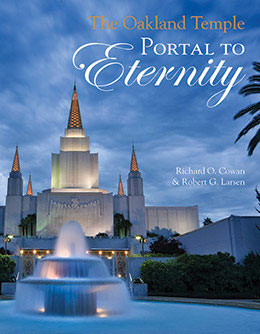Beginnings
Richard O. Cowan and Robert G. Larson, The Oakland Temple: Portal to Eternity (Provo, UT: Religious Studies Center; Salt Lake City: Deseret Book, 2014), 1–15.
1846 Ship Brooklyn sailed from New York (February 4)
Mormon Battalion recruited in Iowa (July 15)
Brooklyn Saints arrived in San Francisco Bay (July 31)
1847 Mormon Battalion arrived at San Diego (January 29)
John Horner was one of first settlers in Alameda County (March)
Brigham Young and Mormon pioneers arrived at Salt Lake Valley (July 24)
President Young sent epistle to California Saints (August 7)
1848 Gold discovered at Sutter’s Mill (January 24)
1851 Parley P. Pratt presided over Pacific Mission at San Francisco
1856 George Q. Cannon published Western Standard in San Francisco (February)
1857 Brigham Young called Saints to return to Utah (fall)
1892 Oakland Branch organized when California Mission was reopened (October 2)
1894 Karl G. Maeser directed Church exhibit in San Francisco.
1896 Tabernacle Choir gave concert in Oakland (April 14)
1898 Wilford Woodruff died in San Francisco (September 2)
1906 San Francisco earthquake (April 18)
1915 Church exhibit at Panama-Pacific International Exhibition attracted interest
(February 28–December 4)
1917 United States entered World War I (April 6)
The story of the Oakland Temple did not begin in California. Rather, its roots go back to the early nineteenth century in the state of New York.
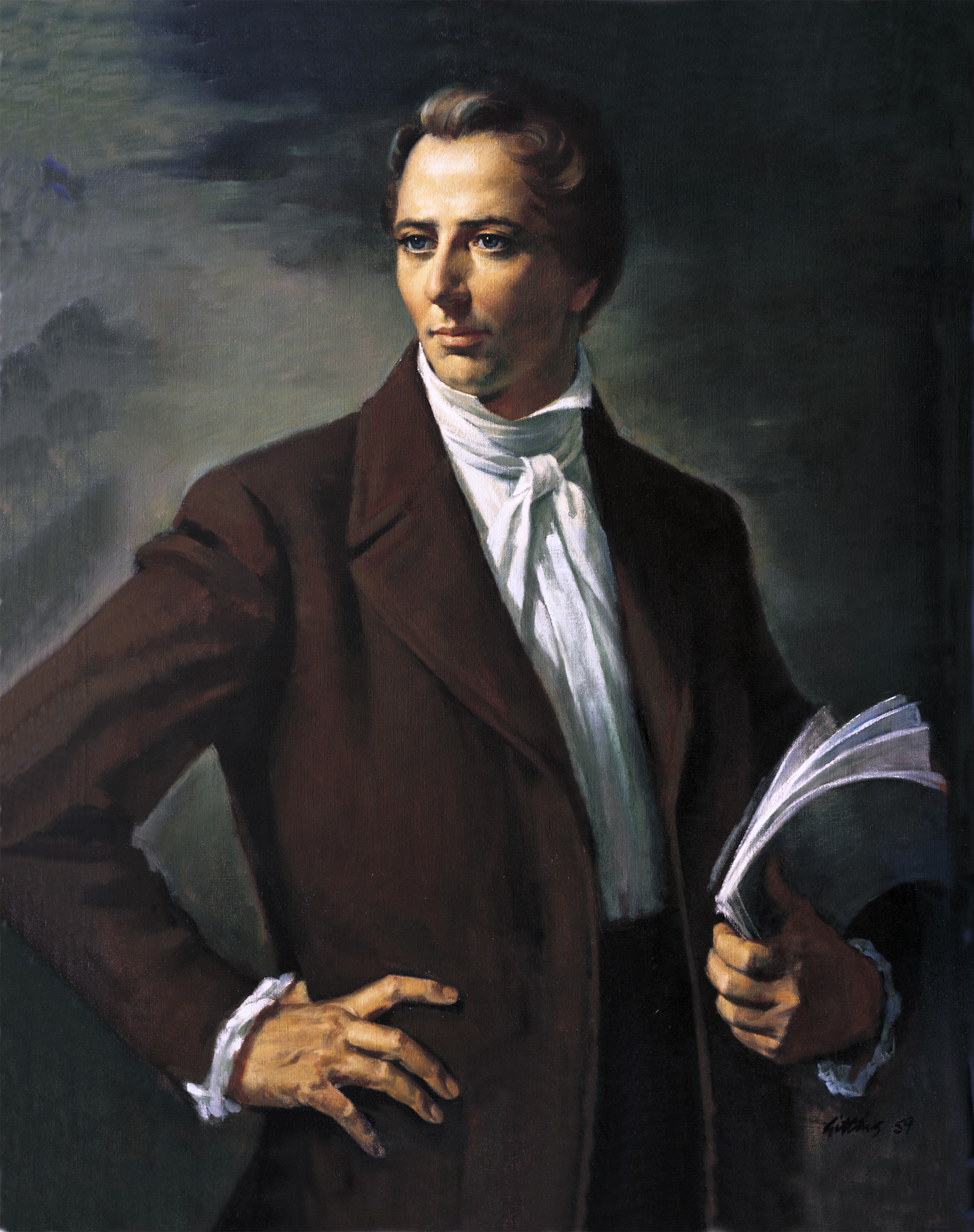 Joseph Smith. Portrait by Alvin Gittins. © Intellectual Reserve, Inc.
Joseph Smith. Portrait by Alvin Gittins. © Intellectual Reserve, Inc.
Latter-day Saint Beginnings
Western New York in the early 1800s has been called the “burned-over district” because of the revivalist fervor that prevailed there. Confused by the conflicting claims of the different churches in his area, fourteen-year-old Joseph Smith in 1820 sought help through fervent prayer. He reported that God the Eternal Father and His Son, Jesus Christ, appeared to him. The young man affirmed that their “brightness and glory defy all description” (Joseph Smith—History 1:17). He was promised that he would be instrumental in restoring the true faith to the earth.
This was only the first in a series of divine manifestations Joseph recorded. Three years later, an angelic messenger named Moroni told him about a religious history of the ancient inhabitants of America. Translated by Joseph Smith, this record was published as the Book of Mormon, named for one of the ancient historians most responsible for its compilation. Among other things, it relates how Jesus Christ visited the Western Hemisphere following His Resurrection and Ascension in the Holy Land to bless His “other sheep” in the New World (see John 10:14–16). Thus the Book of Mormon has been designated as “Another Testament of Jesus Christ.” In 1829, other heavenly ministrants brought back the authority of the lesser (Aaronic) and higher (Melchizedek) priesthoods. All these events led to the formal organization of the Church of Jesus Christ the following year. Thus Latter-day Saints regard their church as a restoration of New Testament Christianity.
Almost from the beginning, Latter-day Saints have been a temple-building and temple-attending people. [1] For them, temples are more than ordinary meetinghouses. They regard temples as truly the “house of the Lord,” where, through holy instructions and sacred “ordinances,” or ceremonies, the faithful learn of their eternal destiny and enter into sacred covenants with God.
At Kirtland, Ohio, the Saints overcame poverty and persecution to build their first temple in the mid-1830s. As the temple neared completion, the Saints who met in it enjoyed a rich outpouring of spiritual gifts—including prophecy, speaking in tongues, and visions of angels. Joseph Smith declared that “this was a time of rejoicing long to be remembered.” [2] These events climaxed with glorious experiences during the day-long dedication of the temple on Sunday, March 27, 1836. One week later, on April 3, Joseph recorded that Jesus Christ appeared in glory to accept the temple, and that Elijah the prophet restored the “sealing keys” (or authority) “to turn the hearts of the fathers to the children, and the children to the fathers” (see D&C 110 and Malachi 4:5–6). Within a few years, the first genealogical societies were organized in both Europe and North America. Latter-day Saints often refer to this interest in our ancestors as “the spirit of Elijah.”
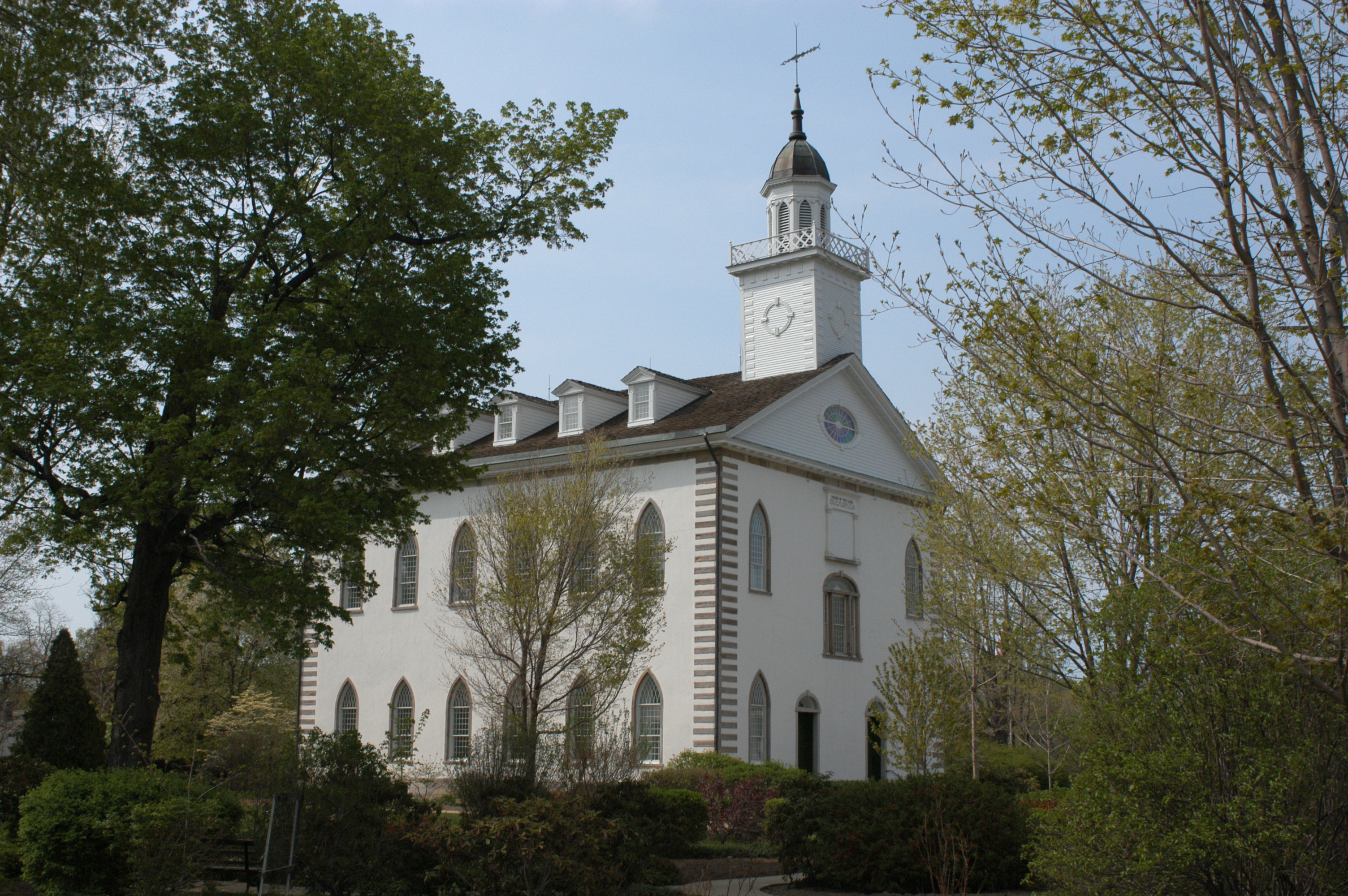 Kirtland Temple. Photo by Craig James Ostler.
Kirtland Temple. Photo by Craig James Ostler.
Sacred temple ordinances were unfolded while the second Latter-day Saint temple was being built at Nauvoo, Illinois. In 1840, Joseph Smith taught the Saints that they could be baptized in behalf of the dead (compare 1 Corinthians 15:29). They eagerly went into the Mississippi River to perform this ordinance, thus making gospel blessings available to their loved ones who had died without this opportunity. In 1842, the Prophet presented the endowment, which prepares participants to return to the presence of God through making and keeping sacred covenants. [3] Joseph recorded that on May 4 he had “spent the day” with a select group “instructing them in the principles and order of the Priesthood, attending to washings, anointings, endowments and the communication of keys pertaining to the Aaronic Priesthood, and so on to the highest order of the Melchizedek Priesthood” and teaching all the “principles by which any one is enabled to secure the fullness of those blessings” and be prepared to dwell in the presence of God “in the eternal worlds.” [4] Soon couples were being “sealed,” or married, “for time and for all eternity” as they made solemn covenants to be faithful to one another and to keep God’s commandments (see D&C 132:7–20). Children could also be linked to their parents through sacred ceremonies performed by priesthood authority.
The forces of religious bigotry climaxed with the murders of Joseph Smith and his brother Hyrum in 1844. As anti-Mormon persecution continued, the Saints in Nauvoo, under the leadership of Smith’s successor, Brigham Young, made preparations for their well-known trek across the plains to new homes in the Rocky Mountains.
Beginnings in California
Church leaders in Nauvoo counseled members living in the northeastern United States not to join them for the lengthy and difficult journey across the plains, but rather to charter a ship, sail to the West Coast, and then make the relatively short overland trip to the Great Basin. Therefore, Samuel Brannan, the presiding elder in the New York City area, chartered the sailing ship Brooklyn and began collecting needed supplies. With 238 Latter-day Saints on board, the ship sailed from New York on February 4, 1846—interestingly the same day that the first overland pioneers departed from Nauvoo and crossed the Mississippi River. [5]
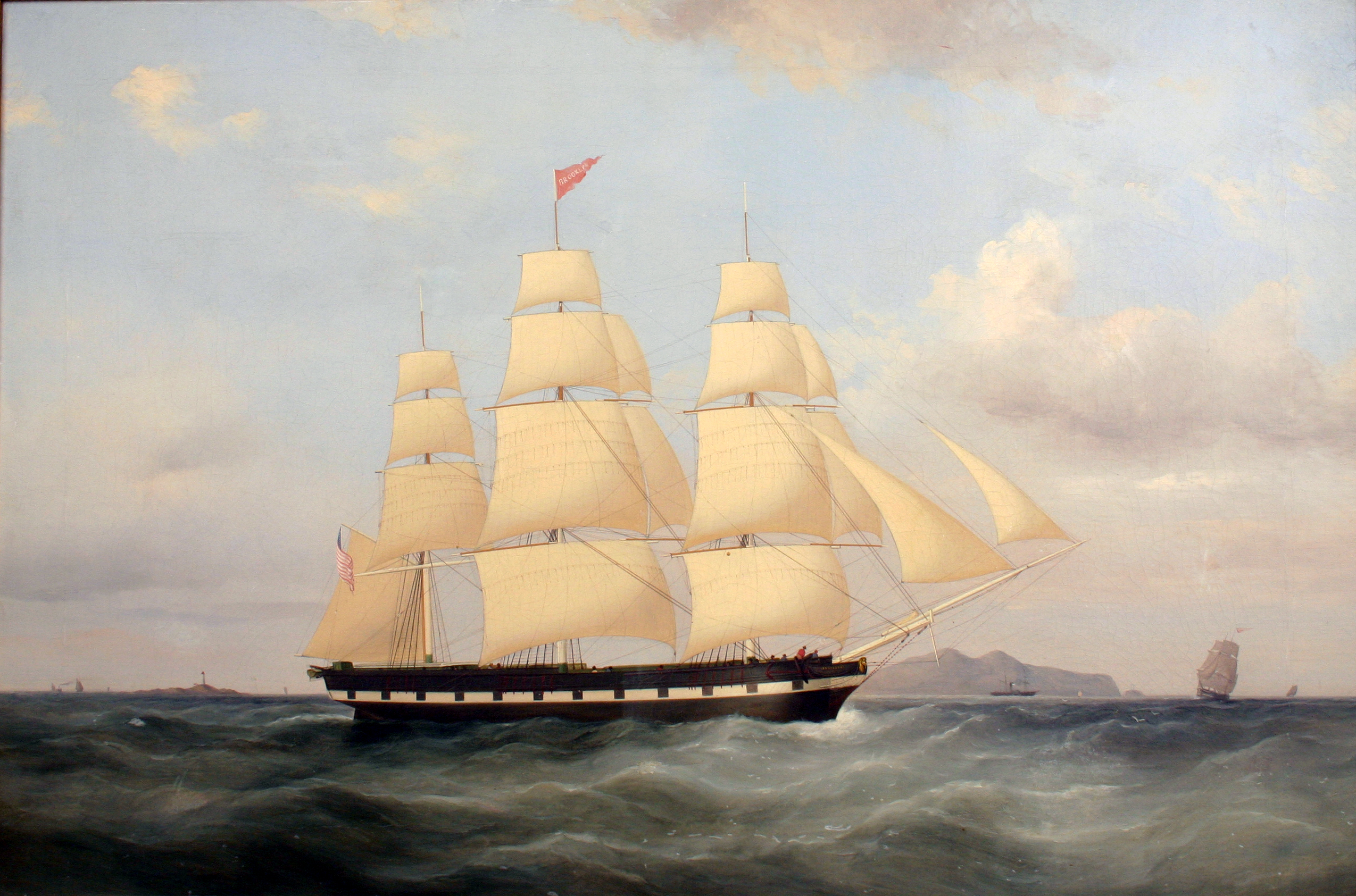 Top: The ship Brooklyn, painting by Duncan McFarlane. Courtesy of Church History Museum. Bottom: Samuel Brannan.
Top: The ship Brooklyn, painting by Duncan McFarlane. Courtesy of Church History Museum. Bottom: Samuel Brannan.
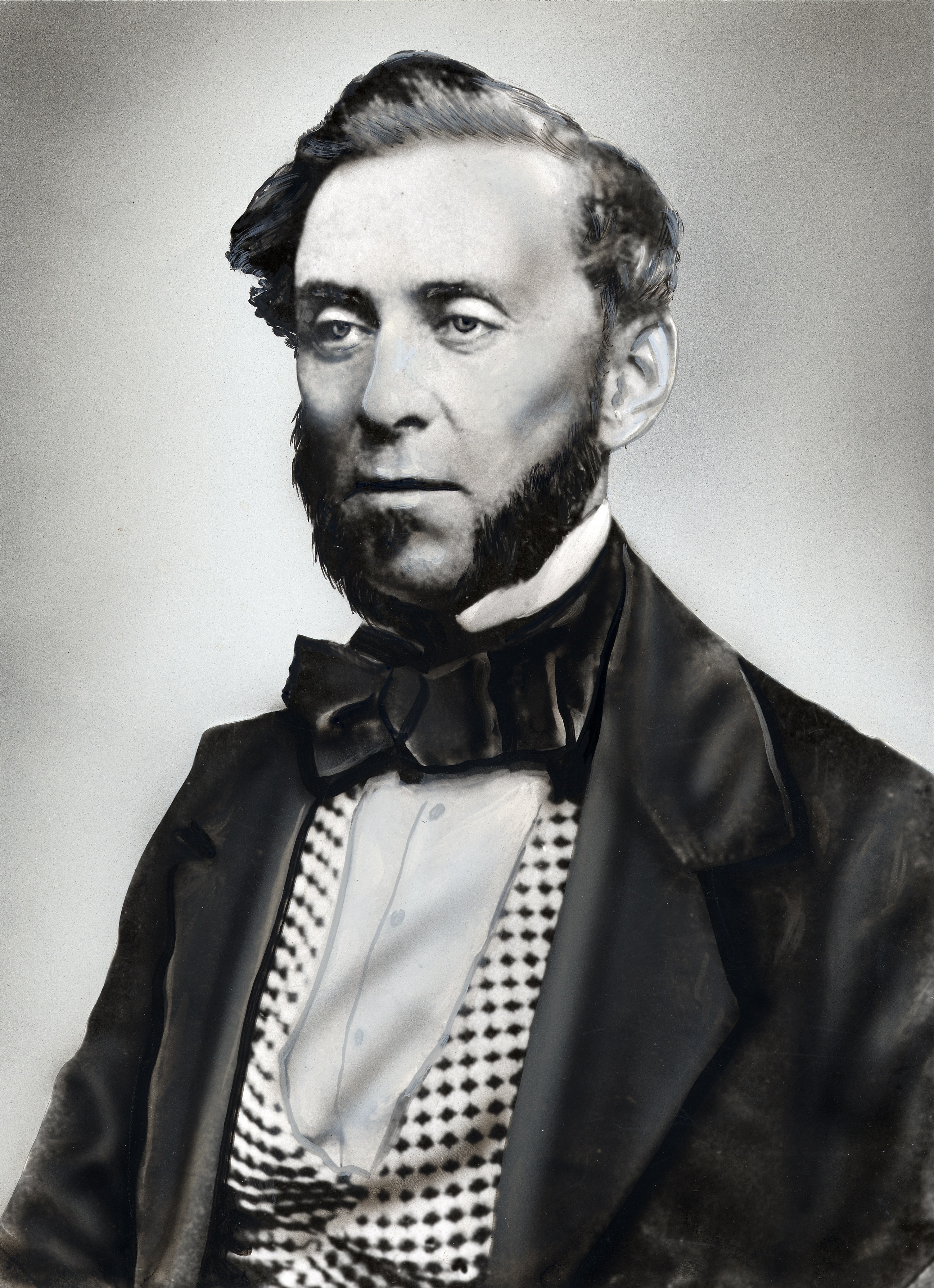
The Brooklyn’s six-month voyage around Cape Horn was undoubtedly one of the longest religious voyages in history. The ship arrived in San Francisco Bay on July 31, 1846, doubling the population of the small Mexican village of Yerba Buena. They were the first Anglos to settle in what would become the city of San Francisco. Thus they established the first Mormon settlement in the West—a year before Brigham Young and the pioneers reached the Salt Lake Valley. They soon established other settlements on the east side of the bay, such as in what they called the “Brooklyn Township,” which eventually became part of Oakland. Another group is credited with raising the first wheat in California’s Central Valley.
In the spring of 1847, Brannan crossed the Sierra Nevada and Great Basin to meet Brigham Young, with the hope of persuading him to bring the Mormon pioneers to California. Brannan met them in present-day Wyoming and then continued with them to the Salt Lake Valley. On August 7, just two weeks after the first body of overland Saints trekked into the Valley, Brannan was preparing to leave for California, undoubtedly disappointed that the main group was not coming with him. Brigham Young and the Twelve Apostles wrote a five-page “epistle” to the Saints in California. In this letter, they reemphasized their decision to remain in the Valley of the Great Salt Lake. The epistle agreed that California was “a goodly land” and that the Apostles did not wish to “depopulate” it of all Latter-day Saints, but they did wish to make the Salt Lake Valley the “stronghold” of the Saints. Nevertheless, the epistle stated that “in process of time the shores of the Pacific may be overlooked from the temple of the Lord.” A century later, Latter-day Saints would interpret this statement as a prophecy that a temple, or perhaps temples, would one day be built on the West Coast. [6]
Meanwhile, in July 1846, the United States Army recruited five hundred able-bodied men from among the Mormon pioneers in western Iowa to fight in the war against Mexico. Following one of the longest infantry marches in military history, the Mormon Battalion reached the Pacific Coast in January 1847. While assigned to duty in San Diego and Los Angeles, these Latter-day Saint soldiers helped to build up both communities. Following their discharge, many of the Battalion men went to Northern California to find work before rejoining their families. One group was digging the millrace on the American River when gold was found. The exact date of this momentous event remained in doubt until the discovery of an entry in the diary of Mormon Battalion member Henry Bigler, who recorded that it occurred on January 24, 1848.
In San Francisco, Samuel Brannan published the first all-English California newspaper, helping spread the stunning news of the gold strike. He soon launched business ventures in Sacramento as well as in San Francisco and became California’s first millionaire. As the Mormons in San Francisco joined the rush to the gold fields, Chinese immigrants took over their abandoned homes. Hence, today’s Chinatown is located roughly in the area originally settled by the Brooklyn Saints.
During March 1847, John M. Horner and his wife, Elizabeth, located choice farming land in present-day Fremont—about twenty-five miles northeast of San Jose. They became the first Anglo family to establish a home in what is now Alameda County (where the Oakland Temple would be built over a century later). After obtaining a team of oxen, he launched his multimillion-dollar farming enterprise. [7] In the spring of 1848, when the Horners learned that gold had been discovered, they joined the rush to get their share, but they found that farming would be more profitable. Miners had to eat, and they could not eat gold. The Horners therefore returned to their farm and replanted vegetables in the fall of 1848. When the real gold rush came in 1849, they were among the few who were prepared to supply fresh produce to the miners. The price of food skyrocketed to such prices that the Horners, like Brannan, became wealthy in a single season.
At the zenith of his prosperity, Horner acquired several hundred acres and employed as many as 150 men. “I fully realized that I must rely upon myself and the Great Father for success,” Horner reflected. “Industry, honesty, and perseverance were my guiding stars.” [8] He introduced new agricultural methods, using the first reaping and threshing machines in the state. [9] At California’s first agricultural fair in 1852, he received the highest awards and was given the title “First Farmer of California.” With his wealth, Horner encouraged and helped many Brooklyn Saints settle on his properties. In a central location he built a schoolhouse and employed a teacher. This building also served as a social hall and as a meetinghouse on Sundays, and therefore it may be regarded as the first Latter-day Saint chapel in California. [10]
During these same years, the influx of gold seekers was transforming San Francisco. The city took on a cosmopolitan atmosphere. Many were northeasterners, so they built upon the Brooklyn colony’s foundation of New England attitudes and styles. In three years the city had grown from a population of less than 500 to 30,000—only about 2,000 of them female. Once the majority, Latter-day Saints now made up less than 5 percent of the population.
In 1849, Church leaders in the Great Basin had assigned two Apostles (Amasa M. Lyman and Charles C. Rich) to go and minister to the Saints in California. Elder Lyman reached San Francisco at the end of May, and Elder Rich arrived almost a year later. They met with the scattered Saints, collected tithing, and encouraged them to leave California and join with the Church in the mountains. As a result, forty men in a wagon train departed in July 1849. Gold brought from California was badly needed to fund colonizing and other activities in Utah. One of the Apostles’ most delicate assignments was to visit Samuel Brannan and obtain from him the tithing funds he had collected, supposedly in the name of the Church. When Elder Lyman asked Brannan for the Lord’s tithes, Brannan reportedly quipped in disgust, “You go back and tell Brigham Young that I’ll give up the Lord’s money when he sends me a receipt signed by the Lord, and no sooner.” [11] The Apostles had more success when both Lyman and Rich visited Brannan together. He gave them $500 (about $16,000 in today’s money) and arranged to turn over the Church books in his possession, perhaps suggesting the end of Brannan’s five-year Church leadership role at the age of only thirty-one. In the fall of 1850, Elders Lyman and Rich returned to Utah, but both were back in the Golden State the following year—this time to establish a Mormon colony at San Bernardino in Southern California.
In 1851, another member of the Twelve, Elder Parley P. Pratt, became president of the Church’s Pacific Mission with headquarters in San Francisco. Upon his arrival, he found approximately fifty Latter-day Saints in the area, only a fifth of the number that had come on the Brooklyn. During the next four years, whenever he was in the city, he was a vigorous defender of the faith. Missionaries traveling to or from assignments throughout the Pacific area frequently gave a boost to the work in California. Missionary work continued in the gold country and also expanded into counties north and south of the Bay. Because the number of converts roughly equaled the total of those departing for Utah or to the Mormon colony in San Bernardino, Church membership in Northern California remained relatively unchanged.
George Q. Cannon came to San Francisco in 1855 to finish and publish his Hawaiian translation of the Book of Mormon. At this time, negative publicity about Mormon polygamy presented an increasing challenge. In February 1856, Cannon launched a Latter-day Saint newspaper, the Western Standard, with its masthead proclaiming, “To Correct Mis-Representation We Adopt Self-Representation.”
In 1857, US president James Buchanan received unsubstantiated reports that the Mormons in Utah Territory were rebelling against federal appointees. Without confirming these reports, he sent an army of 2,500 men to restore order. Not knowing what the presumably hostile army would do, Brigham Young called all missionaries who were abroad, as well as settlers in outlying colonies, to come home and prepare to “defend Zion.” Following these instructions, most Latter-day Saints in California prepared to leave for Utah. Elder Cannon published the last issue of the Standard on November 6 before departing.
Activity Revived
For the next three decades, there was no regular Latter-day Saint organization maintained in California. Many of the Saints who had chosen to remain in the Golden State became disaffected. During the 1880s, however, many Latter-day Saints fled from anti-Mormon persecutions in Utah. Some went to California and became the nuclei around which Church activity would revive. In Oakland there were thirty-six members by 1891. The Church reopened its California Mission the following year, and the local Oakland Branch was officially revived on October 2, 1892.
Dr. Karl G. Maeser, the German educator who had founded Brigham Young University in Utah, briefly presided over the California Mission from January to August 1894. He was sent primarily to arrange and direct an exhibit on Latter-day Saint education at San Francisco’s Mid-Winter Fair. The exhibit was well received and made many friends for the Saints. [12]
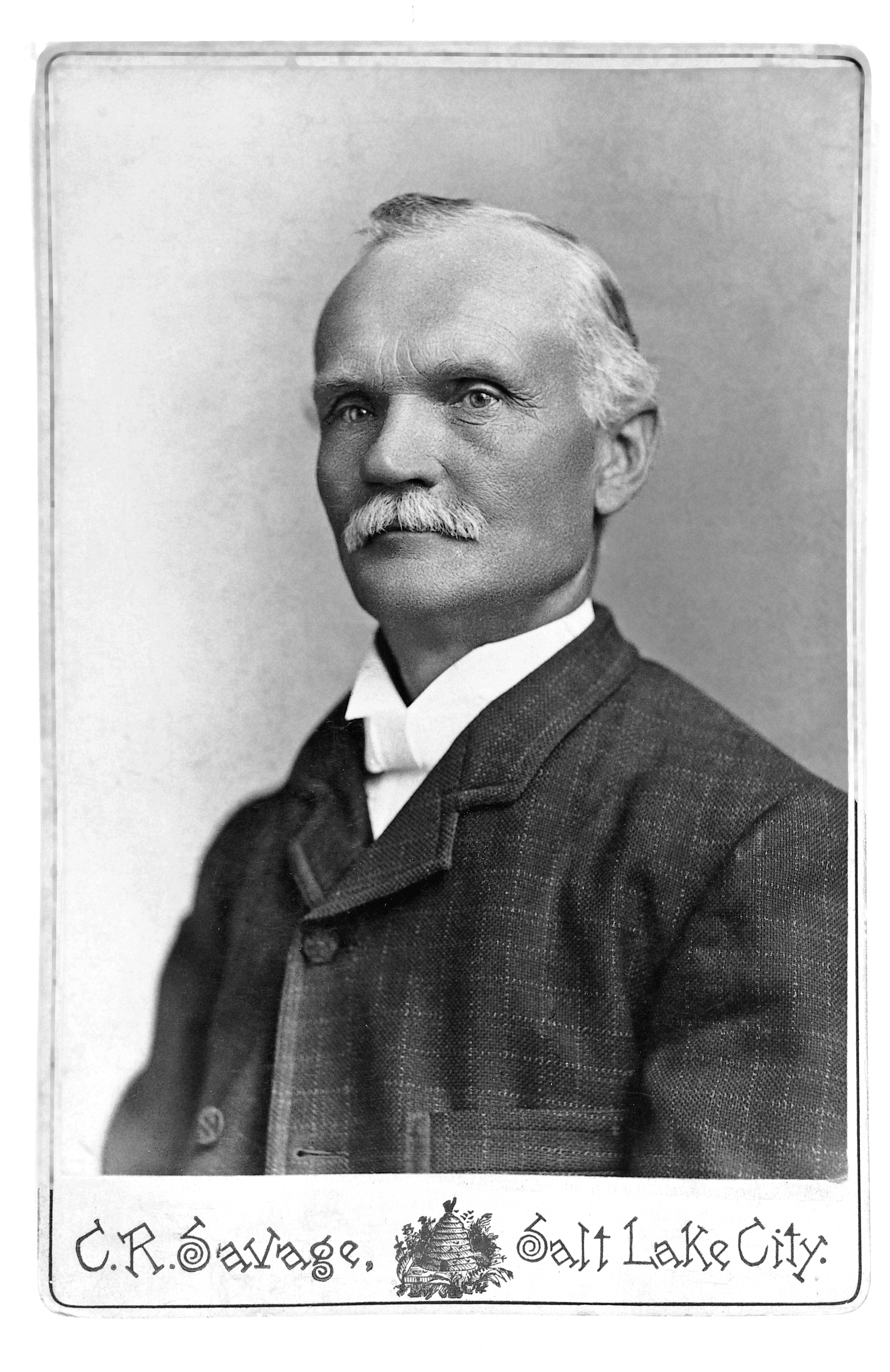 Karl G. Maeser. Photo by Charles R. Savage, © Intellectual Reserve, Inc
Karl G. Maeser. Photo by Charles R. Savage, © Intellectual Reserve, Inc
Church leaders continued to visit California. Several notable visitors came in 1896, which happened to be the fiftieth anniversary, or “jubilee,” of the Saints’ first arrival. On February 9, Apostle Heber J. Grant spoke at a meeting of the San Francisco Branch and attracted a crowd of about two hundred people—a goodly number given the fact that there were only a few Latter-day Saints in the city. Two months later, the Salt Lake Mormon Tabernacle Choir came to perform. This was only the second time the choir had left the Intermountain West. On April 14, the choir, directed by Evan Stephens, presented a concert in Oakland’s First Congregational Church. There were also five concerts performed by the choir in San Francisco. [13]
In June, President Joseph F. Smith, Second Counselor in the Church’s First Presidency, and Apostle Abraham H. Cannon, spent three days with the San Francisco Saints. Lorenzo Snow, President of the Quorum of the Twelve, and his wife and two daughters visited the Saints on August 9. This was the fourth visit to the state by leading Church authorities that year. California was obviously being closely observed.
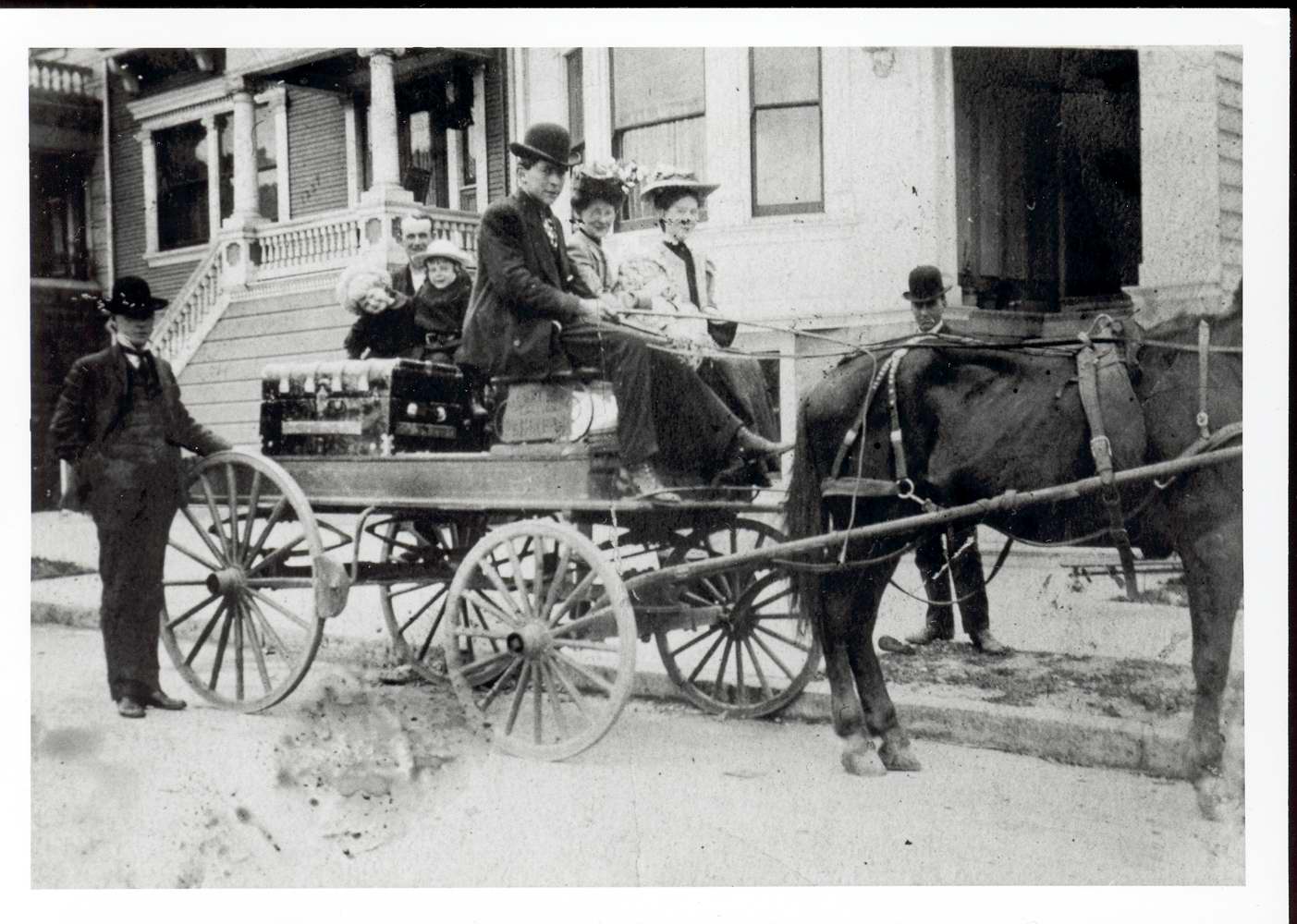 The Brobergs, a Latter-day Saint family, flee their home during the San Francisco fire. Courtesy of Richard Neitzel Holzapfel.
The Brobergs, a Latter-day Saint family, flee their home during the San Francisco fire. Courtesy of Richard Neitzel Holzapfel.
The following year, Californians commemorated the discovery of gold, which had taken place fifty years earlier. Four of the Mormon Battalion veterans who had been at Sutter’s Mill when the strike was made, including Henry Bigler, were able to attend the celebration, and they received royal treatment.
Church President Wilford Woodruff had recruited the aid of Isaac Trumbo and other political leaders in California during Utah’s bid for statehood and visited these friends in California from time to time. On August 21, 1898, he addressed a meeting of the San Francisco Branch. This would be his last public discourse because he soon became gravely ill and died on September 2 at Isaac Trumbo’s Sutter Street home.
The 1906, the San Francisco Earthquake and Fire interrupted Latter-day Saint progress in the Bay Area. At 5:12 a.m. on April 18, the devastating earthquake struck. The resulting fires destroyed 490 blocks, including mission headquarters on Franklin Street. Some of the Saints who lost their homes camped out in a park near this location. As the mission president helped provide relief, he noted that the Saints were “more attentive to their duties since the dread calamity.” [14] Rather than rebuilding in San Francisco, the Church decided to move mission headquarters to Los Angeles, where the work was expanding rapidly.
In 1915, several specialized “congresses” were organized in conjunction with San Francisco’s Panama-Pacific International Exposition. Latter-day Saints were invited to organize and conduct several sessions at the International Congress of Genealogy. A special chartered train called the “Utah Genealogical Special” brought 250 persons from Utah, including all three members of the First Presidency, who spoke at sessions of the Genealogy Congress. These Church leaders were received cordially and with great respect. Another significant Latter-day Saint representative was Apostle James E. Talmage, who addressed the Congress of Religious Philosophy on “The Philosophical Basis of Mormonism.” Dr. Avard Fairbanks, famed Utah artist and sculptor, also made his first visit to California to exhibit his work. These visitors attracted much favorable attention to the Church and its members. [15]
On April 6, 1917, the very day Latter-day Saints gathered in the Salt Lake Tabernacle for their annual general conference, the United States entered World War I. The war would attract more Church members to California than ever before, ushering in a new chapter of Latter-day Saint history in the Golden State.
Notes
[1] For a discussion of Latter-day Saint temples, see James E. Talmage, The House of the Lord (Salt Lake City: Bookcraft, 1962); Boyd K. Packer, The Holy Temple (Salt Lake City: Bookcraft, 1980); Richard O. Cowan, Temples to Dot the Earth (Springville, UT: Cedar Fort, 1997).
[2] History, 1838–1856, volume B-1 [1 September 1834–2 November 1838], http://
[3] Talmage, House of the Lord, 99–100.
[4] “History of the Church” (manuscript), book C-1, pp. 1328–29, Church History Library, The Church of Jesus Christ of Latter-day Saints, Salt Lake City.
[5] For a more complete review of Latter-day Saint history in California, see Richard O. Cowan and William E. Homer, California Saints: A 150-Year Legacy in the Golden State (Provo, UT: Religious Studies Center, 1996).
[6] Journal History of The Church of Jesus Christ of Latter-day Saints, August 7, 1847, Church History Library, Salt Lake City, as cited in Cowan and Homer, California Saints, 98.
[7] John M. Horner, “Looking Back,” Improvement Era, November 1904, 32–33.
[8] Horner, “Adventures of a Pioneer,” Improvement Era, May 1904, 513.
[9] Horner, “Voyage of the Ship ‘Brooklyn,’” Improvement Era, September 1906, 890.
[10] Horner, “Adventures of a Pioneer,” Improvement Era, August 1904, 770; Leo J. Muir, A Century of Mormon Activities in California (Salt Lake City: Deseret News Press, 1952), 1:38.
[11] Erwin G. Gudde, Sutter’s Own Story (New York: G. P. Putnam’s Sons, 1936), 202.
[12] Alma P. Burton, Karl G. Maeser: Mormon Educator (Salt Lake City: Deseret Book, 1953), 62.
[13] J. Spencer Cornwall, A Century of Singing: The Salt Lake Mormon Tabernacle Choir (Salt Lake City: Deseret Book, 1958), 70.
[14] Joseph E. Robinson to the First Presidency, June 29, 1906, as cited in William G. Hartley, “Saints and the San Francisco Earthquake,” BYU Studies 23, no. 4 (Fall 1983): 457.
[15] Gerald Joseph Peterson, “History of Mormon Exhibits in World Expositions” (master’s thesis, Brigham Young University, 1974), 38–39.
